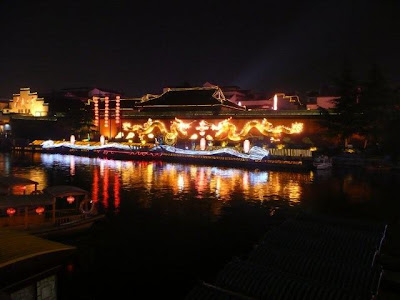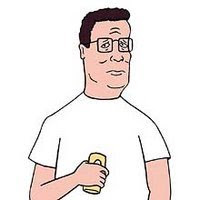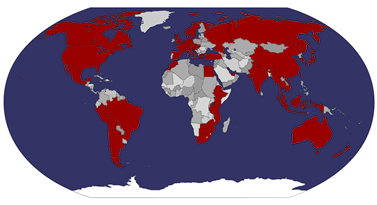At Nanjing, the capital of Jiangsu province, I’m quick out, collect my bag and find Mei waiting for me in the arrivals area. I love people picking me up at airports! She gives me a choice – two buses and a couple of hours, or a taxi. Done. It’s actually quite far from town – almost an hour, and the cab ends up being quite expensive – 110 with toll fare. I’m staying at the Fuzimiao YHA, at the edge of Fuzi Temple, which Mei talks down, but is in fact a cool place in a renovated temple building. The reception are friendly and don’t seem me to mind cutting down my stay to one night. My room is a bit stale without a window – Mei moved rooms because of this and having ants in the bathroom, but for the price, 120 for one night, one can’t complain too much. There’s a decent shower!

After dumping bags, we head out. Nanjing lies on the southern side of the Yangzi, and on the east is bound by Zijin mountain, where most of the historical sites are. Mei’s been here a day and so has done lots of the standard tourist things here already. We decide to walk to the Memorial Hall of the Nanjing Massacre, a good walk to the west from where we are. This documents the atrocities committed by Japanese soldiers against the civilian population during the occupation of Nanjing in 1937. They include photos of actual executions. Apparently it concludes on a more positive note, with a room dedicated to post-1945 Sino-Japan relations.
We walk along the tree-lined street, and I find a queue of people at a shop front. We have to queue, I tell Mei.

What for? I don’t know, but it must be good with all these people waiting for it. Turns out to be roasted chestnuts at a bargain price, so we wait for our turn, and I pick up a kilo for 5.90Y.

They’re tasty, but not the easiest to eat, with the flesh sticking to the shell in quite a few. Onwards, and eventually we reach the site where the museum should be. There’s a big construction site. While Mei asks for directions, I buy some satsumas.

The woman keeps putting them in to the bag whilst I ‘m momentarily distracted, and I end up with a lot.. perhaps 2kg of satsumas! What am I going to do with all of these?!

The smile is because she’s busy giving me twice as many as I asked for
Turns out the Memorial Hall is being redeveloped, so we hop on a bus up to the next place of interest, the Nanjing Treaty History Room. When we get there, we find this also is all being redeveloped.

What is going on, is anything old being left in China?! We eat some beef and lotus root stuffed with rice to contemplate this serious issue.


Jinghai Temple and Nanjing Treaty Propaganda
Then we wander into Jinghai Temple and find the History Room inside.

It’s actually better than LP suggest, as it has English subtitles, but what a piece of propaganda!

First we pass an exhibition dedicated to a famous early Chinese navigator, with some beautiful art:



The sun is getting low, and I’d like to ascend the temple on the hill behind, so we have to hurry up!

The Nanjing Treaty was the one where Hong Kong was ceded to Britain. The history was that the British wanted to trade with China, but China had no interest in this. After trying several times by diplomatic means to open up ports on their coasts, the Opium Wars were triggered, which China lost. Rather honourably one might say, Britain did not take advantage of this situation, instead signing a treaty saying we’ll borrow Hong Kong from you for 100 years, and at the end, we’ll give it back, which we did.

1997
However, the spin put on events in this museum is somewhat different. It was the first unequal treaty ever in China apparently, and the aggressors sank their imperialist claws into etc etc. It was funny to read, but this is the official spin in China. To be honest it was such a loaded history, full of the sourness of the losing side, that you start to wander how much of the Nanjing Massacre is true. Certainly what is not highlighted is the part the Chinese played, locking the gates to the city.
Yes, the Nanjing Massacre was foreseen. The Chinese army was underfunded and ill-prepared to resist the Japanese, that is to say they would clearly lose, but the authorities told people to stay, saying “All those who have blood and breath in them must feel that they wish to be broken as jade rather than remain whole as tile”. The authorities then locked the gates to the city, trapping half a million citizens inside and leaving them to the mercy of the Japanese. I would suspect knowing Chinese military patterns, that those responsible for this decision did not remain and fight.

The British Aggressor’s Claws

Bandits!
I suppose we’re used to such impartial assessments of history that coming across something like this is somewhat surreal.

Where they worked out the treaty

What it looked like
Having had enough of this claptrap, I tell Mei it’s time to go, so we head out of the museum, turn left, go through the large gate which as the Ming city walls lead off from it must be an old city gate.

We pay the very expensive entry fee, and start climbing up in the now coolish air, passing an amusingly-named pavilion:

Love-sickness carrying pavilion
Soon after we reach the base of the temple. It still seems quite high from where we are!

Dragon eats the sun

Sun set under the temple stack
To go any further, unfortunately we need to descend a couple of floors before being able to climb again! We enter the temple and start climbing the staircases up, which get progressively smaller. At the top, we catch our breath outside as we walk round the balcony, enjoying great views of the city and the Yangtze river.

Sun set over the Yangtze
Once the sun is down, it soon gets cold, so we head quickly down, passing some beautiful calligraphy and a throne of some kind.

Art from characters

Writing behind the throne

The throne itself
We catch another bus, this time to centre of town somewhere.

No tractors down here please
There’s a long wait, so when one comes eventually , it’s absolutely packed, so we have to pay the driver, then step back off and shove ourselves in the middle door! The driver is terrible constantly stop-starting to throw everyone about. It seemed like he had no clutch at all! The challenge as usual is trying to work out where we are. We get off at almost the right stop, and decide to take the Metro, as I haven’t taken it yet.
In the entrances, there is a bizarre list of what’s not allowed

In particular:

No piling allowed
We head to a lively area around the canals not far from where we’re staying. There are traditional style buildings everywhere, with neon lights and red lanterns reflecting in the canal.

Mostly local tourists enjoying the evening

Canalside

Lantern-laden bridge

Lanterns
It’s dinner time, so we head upstairs into a hotpot restaurant. Mei does well to order a good selection of food, but she does lose brownie points by going for a split pot – she uses the non-spicy food for most of her bits. I must admit it’s rather peppery!

Split hot pot
We don’t finish everything, and I realise why when Mei steers us to Haagen Dazs!

Money grows on trees in China
They have a large advert for their green tea ice-cream as we go in. Well I won’t be needing the menu then!

That’s what I’m here for!

Especially with all their chocolaty toppings
Sun Yatsen and a Hill
Mei gets us up at a respectable hour, and we head next door for breakfast. They do dough sticks, something one generally has with congee (a porridge made from rice). We skip the congee. The dough sticks are great, big crunchy and tasty – when I tried to make these at home once I ended up with small hard cigar-sized lumps of dough.

Delicious oily dough sticks
Today we’re heading to Zijin Mountain at one edge of Nanjing. We stumble across a Starbucks on the way.

Starbucks and Costa cooperating?!

Green Tea cheesecake, yummm
Sun Yat Sen Mausoleum
Dr Sun Yat Sen is regarded as the father of modern China. He was the first president of the republic formed in 1911. The entry fee for the whole complex had been hiked up significantly from LP’s (May ’07) information, something of a theme in China. It’s very touristy, with a line of shops selling tat to be passed before you get in.

Rong Hua Cigarette Wine Edible Drink. Curious

One of the more obscure museums I’d be willing to bet
Inside, we head up the hill via a series of small temples, before some steep steps start. The weather is quite overcast and hazy.



Up the steps
We’re fortunate it’s not too hot in fact for the climb, though I wonder whether it’s worth climbing the hill behind afterwards.

View from the top down
This is a place of respect – a guard makes sure people respect the “No photographs” signs. There’s also a sign telling visitors to salute. I consider doing a Python-esque goose-step. No one would get it anyway.

The Doctor

A smart ceiling

The man himself
Unfortunately we can’t head straight up the hill from here – we need to go down then come back up to ascend Zijin Shan (Purple Gold Mountain).

Pretty flowers

Well spotted Mei
It’s slightly difficult to work out exactly where the trail up the hill starts. I contemplate taking the train!

The easy way about
This must be it:

Suckers for punishment this way please
The hillside is heavily forested, providing a pleasant walk up. We don’t meet anyone else going up, I think the Chinese way to do this mountain is to take the cable-car up on the other side, then walk down. Far more sensible!

The sign next to their logs says “please preserve the environment”

Trail up
The view from the top is very pleasant, though we don’t have the visibility one would hope for because of the low cloud.

Top
We’re running out of time, so take the cable car down. It’s quite a flimsy affair, though good fun. I’m surprised at how long it is. Half way down there is an observatory, which would have been interesting to visit.

Cablecar down for speed
At the bottom we hop on a bus to the centre, then after a quick bakery visit and a second bus, we go looking for the 10,000 Buddhas Vegetarian Restaurant in Pilu Temple. Again a nightmare to find, but when we do get there, we find the restaurant has closed.
I have a surreal experience as a strange old man who I assume is some kind of begger tries to give me a cigarette. I politely refuse. He tries again. I refuse. He tries to thrust it into my hand, and I begin to get a bit annoyed, so walk off, leaving him to talk to Mei. Eventually as we leave he pulls out an apple from his pocket and shoves that into my hand instead. Bizarre. The apple is offloaded to Mei!
The next area is full of high towers and new developments, work on which is still going on.

Towers

Soon, soon
We’re heading round to another LP-recommended restaurant, one which hopefully is open later than 5pm.
Sichuan Jiujia Restaurant

LP says look for the dancing chilli neon

The restaurant
This place is famous for Nanjing pressed duck (yanshui ya), where the duck is slathered in roasted salt, steeped in clear brine, baked dry and then kept under cover for some time. The finished product has creamy skin and tender pink flesh, and is delicious!

Spicy chicken on left, Nanjing pressed duck on right

Tea and beer

Bags covered
We head back to our hostel, and I need to head off fairly quickly as I’m taking the bus to the airport. From here to the bus terminal I could walk but as I’ve got my pack with me I decide to take a cab. I show him the bus terminal on my map, he agrees. He drives off in the wrong direction.
After a minute or two I start querying why he is driving this way – I point again and say the name of the bus station. He replies with lots of Mandarin. I just point at the bus station, it’s fairly damn clear where I want to go. Then he asks me if I’m going to the airport. I hesitate before agreeing, I know how it will be interpreted if I say yes. I say yes, and he turns and heads down the freeway to the airport. No no no, I tell him. The bus station. I’m trying not to get angry but how many times can I ask him to go to one simple place that I’m pointing to on the map.
He comes off the freeway and loops round almost the whole town before finally coming back to the bus station, which would have been a five or ten minute walk from my hostel. Touts for the unofficial buses and taxis immediately come up to the window. When it comes to paying, I give him 10 – it would have been 9 as we wouldn’t have tipped over the flag amount. He points at 18 or 19 on his meter. I point to the map and indicate the extremely circuitous route he’s just taken. The touts actually help out at this stage, as they ask him where he’s just come from and laugh at him when he says FuziMiao. He accepts my 10.
Having received their help, I ignore the touts and go straight into the bus station, to the back, where the official airport bus leaves. It’s not long till I’m at the airport, checked in, and through the sensible security in China, where they allow 1L of liquids on board (they reserve the right to smell liquids). 1L of course is more than enough for you to take your toothpaste and a small bottle of water, all that most people want to do. How refreshing, and a lesson for BAA incompetents back home.
I enjoy some expensive tea but with free refills in a café before boarding. Quick, one more pour from the kettle, I must get my money’s worth!




No comments:
Post a Comment